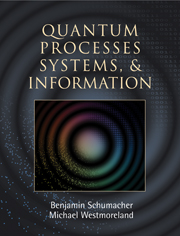Book contents
- Frontmatter
- Contents
- Preface
- 1 Bits and quanta
- 2 Qubits
- 3 States and observables
- 4 Distinguishability and information
- 5 Quantum dynamics
- 6 Entanglement
- 7 Information and ebits
- 8 Density operators
- 9 Open systems
- 10 A particle in space
- 11 Dynamics of a free particle
- 12 Spin and rotation
- 13 Ladder systems
- 14 Many particles
- 15 Stationary states in 1-D
- 16 Bound states in 3-D
- 17 Perturbation theory
- 18 Quantum information processing
- 19 Classical and quantum entropy
- 20 Error correction
- Appendix A Probability
- Appendix B Fourier facts
- Appendix C Gaussian functions
- Appendix D Generalized evolution
- Index
18 - Quantum information processing
Published online by Cambridge University Press: 05 June 2012
- Frontmatter
- Contents
- Preface
- 1 Bits and quanta
- 2 Qubits
- 3 States and observables
- 4 Distinguishability and information
- 5 Quantum dynamics
- 6 Entanglement
- 7 Information and ebits
- 8 Density operators
- 9 Open systems
- 10 A particle in space
- 11 Dynamics of a free particle
- 12 Spin and rotation
- 13 Ladder systems
- 14 Many particles
- 15 Stationary states in 1-D
- 16 Bound states in 3-D
- 17 Perturbation theory
- 18 Quantum information processing
- 19 Classical and quantum entropy
- 20 Error correction
- Appendix A Probability
- Appendix B Fourier facts
- Appendix C Gaussian functions
- Appendix D Generalized evolution
- Index
Summary
Quantum circuits
If the state of a quantum system is a kind of information, then the dynamics of that system is a kind of information processing. This is the basic idea behind quantum computing, which seeks to exploit the physics of quantum systems to do useful information processing. In this chapter we will acquaint ourselves with a few of the ideas of quantum computing, using the idealized quantum circuit model. Then we will turn our attention to an actual quantum process, nuclear magnetic resonance, that can be understood as a realization of quantum information processing.
In a quantum circuit, we have a set of n qubit systems whose dynamical evolution is completely under our control. We represent the evolution as a sequence of unitary operators, each of which acts on one or more of the qubits. Graphically, we represent the qubits as a set of horizontal lines, and the various stages of their evolution as a series of boxes or other symbols showing the structure of the sequence of operations. In such a diagram, time runs from left to right (see Fig. 18.1.). The n qubits form a kind of “computer,” and its overall evolution amounts to a “computation.” The key idea is that very complicated unitary operations on the n qubits can be built up step-by-step from many simple operations on one, two or a few qubits.
Information
- Type
- Chapter
- Information
- Quantum Processes Systems, and Information , pp. 366 - 389Publisher: Cambridge University PressPrint publication year: 2010
